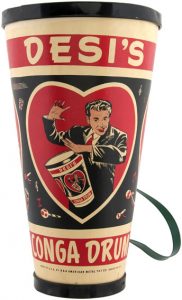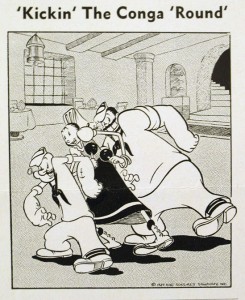During the term of Franklin D. Roosvelt, the United States decided to try a new idea in our relations with the nations of Central and South America. This became known as the “Good Neighbor Policy”.
 Before Roosevelt, we had not necessarily been good neighbors at all times. We had shown no compunction about invading a Central American or Caribbean country when it suited our interests (or those of the United Fruit Company).
Before Roosevelt, we had not necessarily been good neighbors at all times. We had shown no compunction about invading a Central American or Caribbean country when it suited our interests (or those of the United Fruit Company).
And, although there was no governmental ukase telling us that we should expose ourselves to the music of these more humid zones–we were getting exposed to these musics and these rhythms anyway.
The rumba had come to our shores in the early 1930’s, as related in earlier articles on this Site. And the late Thirties saw a new rhythm brought over from Cuba—the Conga.
What set the Conga apart from the Cuban dances that had come before was a slightly faster tempo–and its “one-two-three-KICK” rhythm, which caught the public’s fancy once they had gotten a taste of it.
New York’s Cuban community already knew of the Conga by around 1937 thanks to Xavier Cugat. And, in 1939, it reached the Broadway and night-club crowd–helped along by a conga-drummer whose story was right out of Horatio Alger. He went by the name of Desi Arnaz.
Arnaz opened up at the “La Conga” nightclub on Manhattan isle in 1939, and soon was leading excited lines of tuxedo-clad males and evening-gowned society dames in long serpentine conga lines, snaking in, around, and out of the nightclub into the street.
 Cartoons discovered the appeal of the Conga, as demonstrated by its appearance in such Warner Bros. ‘toons as Hollywood Steps Out (1940) and Lights Fantastic (1942). And it would provide gag material, even on a baseball field–as in Warners’ Baseball Bugs (1946) and in Terrytoons’ Mexican Baseball (1947).
Cartoons discovered the appeal of the Conga, as demonstrated by its appearance in such Warner Bros. ‘toons as Hollywood Steps Out (1940) and Lights Fantastic (1942). And it would provide gag material, even on a baseball field–as in Warners’ Baseball Bugs (1946) and in Terrytoons’ Mexican Baseball (1947).
And it even filtered down to the Miami eyrie of Max Fleischer and his crew–who got Popeye to go with the conga beat.
Kickin’ The Conga Round (copyright 1942) is a typical wartime Popeye short. Popeye and Bluto are back in the Navy, and while they are still adversaries, they are closer to being buddies than they had been in most of their earlier shorts.
The plot is pretty predictable. Popeye and Bluto are at liberty in an un-named Latin country, go out to see a girl who works as a dancer, an wind up at a night club that features the conga.
Popeye can’t dance at first, and is embarrassed by Bluto, until the one-eyed sailor man gets around some spinach, congas all over the place, and beats Bluto up–until they are both rousted by the Shore Patrol, .. After that, one figures there’ll be no more liberty for them–not for a whle, anyway.!
Aside from the conga rhythm, the music here is pretty generic in sound, played by what sounds like an underfed ten-piece band that features clarinet trios as a favorite voicing.
By the time this cartoon came out, it looked like Max and Dave Fleischer were being shown the door by Paramount Pictures. And with all the turmoil going on, you’d expect that the staff that remained might well have thought that they could take the story idea of Kickin’ The Conga Round –and do it better.
A couple of years later, they would get the chance to do just that!
Next Week: Popeye Goes Latin – Part 2


 James Parten has overcome a congenital visual disability to be acknowledged as an expert on the early history of recorded sound. He has a Broadcasting Certificate (Radio Option) from Los Angeles Valley College, class of 1999. He has also been a fan of animated cartoons since childhood.
James Parten has overcome a congenital visual disability to be acknowledged as an expert on the early history of recorded sound. He has a Broadcasting Certificate (Radio Option) from Los Angeles Valley College, class of 1999. He has also been a fan of animated cartoons since childhood.












































One of the things of note about the cartoon (aside from how the studio managed to sneak the Cab Calloway-ish drug reference past the censors in the post-Code cartoon’s title) is that the Popeye-Olive-Bluto triangle actually had not been used by the studio for the previous 18 months. The Fleischers had spent the latter part of 1940 and the first half of 1941 trying to make Poopdeck Pappy into a star, and had put Bluto on the sidelines (something they had done for almost all of 1938 as well).
“Kickin’ The Conga ‘Round” is a cartoon in two parts, which borrows much of its second half from 1934’s “The Dance Contest”, resurrects Bluto to do it and puts him in the white sailor’s suit for the first time. But it has a decidedly non-formulistic ending, with Popeye joining Bluto in being booted back to the ship, and is one of the first cartoons that fully ‘gets’ the West Coast animation style of speed and comic timing, which the studio had been slow/reluctant to pick up since the move to Miami (and even before then, head animator/director Tom Johnson had shown a desire to use Bluto in a far more comic and less menacing way that he had been used previously by the studio, when Johnson finally got a chance to direct Popeye shorts and use the character in late 1939 and early ’40).
Yes, I think that was the scene where the maracas player was grooving with the conga band and did a type of dance move which the unseen censor somehow used a large banner with the word “CENSORED ” covering the maracas player who did that questionable move. And note the audience in the club look like characters from a Superman cartoon (which the Fleischer Bros also animated for Paramount).
Apart from the “Chinese” sequences, “Lights Fantastic” still seems a charming and lively cartoon.
It’s awfully convenient for Bluto that Popeye’s chest doesn’t appear reversed in the mirror! That said, it sounds like We’re on our way to Rio next week!
Love this cartoon! Especially when Bluto and Popeye gets into a conga infused brawl on the club’s dance floor and Doña Olivia (Olive Oyl) ran out screaming “HELP! HELP! HELP!” and at first i thought the local authorities were going to show but instead it was The Shore Patrol (which is the United States Navy’s version of the Military Police) shows up and one shouted “Look a coupon of Jeebs!” And after they broke up the brawl by shouting “ATTENTION!!!!”, ant escorted both Popeye and Bluto (in a conga beat) back to the ship where they will spend the rest of their Shore Leave in the Brig (a jail or holding cell inside the ship) for their disruptive behavior while on Shore Leave. I’m wondering if anyone knows what the slang word “Jeebs” came from?
“May I butt in?” — priceless!
Dunno what a “jeeb” is, even after a few dozen turns at Shore Patrol duty.
Is ‘jeeb’ what they’re saying? I always thought it was ‘jeep’, as in Eugene.
Just curious, since the Fleischer Bros had thier animation studios in Miami Florida I wonder if they went to Havana Cuba (about 90 miles from Florida) to get their inspiration at the nightclubs like The Tropicana,The Copacabana The Kasillito Club Havana Club & The Zombie Club (yup that’s the name of the nightclub!) for Kicking the Conga Around
Interesting name for a Havana club.
“Zombie” is also the name of a rum-based cocktail that was quite popular in that era. In one of their movies, the Ritz Brothers walk into a bar and order, “Three zombies!” Bartender: “I can see that. What’ll ya have?”
Although this is no place for politics, the statement “Before Roosevelt, we had not necessarily been good neighbors at all times. We had shown no compunction about invading a Central American or Caribbean country when it suited our interests (or those of the United Fruit Company).” suggests a little too much that by World War II the US had bettered its life. This is not true: Since 1945 the US has invaded five American countries: Cuba (1961), Dominican Republic (1965), Grenada (1983), Panama (1989) and Haiti (1994). Apart from that during the cold war the US has actively supported several oppressive regimes in order to keep Latin America from turning communistic, followed by a ‘war on drugs’ in the post-cold war age, with military actions in Colombia and Honduras. So, whether the US have been good neighbors since World War II is open for debate.
BTW, I love the conga craze cartoons of the late 1930s and early 1940s!